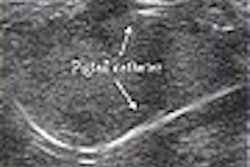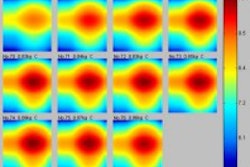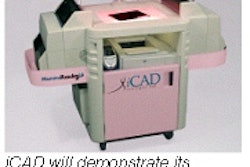VIENNA - It's a vexing problem for breast imagers -- marker clips placed during vacuum-assisted biopsy procedures mysteriously move into new positions, in some cases as far as 5 cm away from the original abnormality. A group of U.K. researchers presented a study at the European Congress of Radiology today that sought to explain the reason for the dislocation, and describe a system for predicting which types of clip placements are most prone to movement.
Many breast imagers are experiencing success in total lesion removal with vacuum-assisted breast biopsy using devices like the Mammotome (Ethicon Endo-Surgery). But if follow up is needed, it's difficult to identify where the lesion was located if all of it has been removed. Breast imagers have been using marker clips for this application, but the movement makes the clips less valuable for localizing biopsy sites, according to Dr. Ruchi Sinnatamby at Addenbrookes Hospital in Cambridge.
"We wanted to look into why this happened in a little more detail to try and work out, while the patient is still on the stereotactic table, whether we can predict why these things go wrong, and more importantly, to try and work out how we can fix it before the patient gets off the stereotactic table," she said.
The Addenbrookes researchers prospectively studied 115 consecutive prone biopsies of microcalcifications, in which 69 clips were deployed. Of those cases, 34 had enough residual microcalcification left after biopsy to give the researchers a good idea of the original target area. They then compared the target area to the final location of the clip after the biopsy was completed.
In some cases, clips had remained in position, and were only a few millimeters away from the microcalcifications that represented the original target area. In other patients, the clips had moved as much as 5 cm. The mean dislocation was 15 mm, Sinnatamby said.
The group determined that marker clips that had moved 15 mm or less were still usable in terms of identifying the original biopsy target. A dislocation greater than 15 mm was considered problematic, however, so the group set out to identify which patients might be prone to greater degrees of clip movement.
The researchers measured target area and original biopsy locations in three axes -- horizontal, vertical, and depth. Repeating the same measurements for the final clip locations, they found there was little clip movement in either the horizontal or vertical planes. But they found significant movement in the depth axis, roughly correlating to the track created by the Mammotome needle as it moves through the breast, removing breast tissue along with the lesion, Sinnatamby said.
Sinnatamby concluded by advising breast imagers to evaluate their clip placement coordinates in the depth plane before releasing the clip to ensure as accurate a placement as possible in the depth axis. Such a placement should result in less clip movement, she said.
"We can start to predict that if on prone (biopsy) units you have a depth difference between your clip and your original target of less than 5 mm, then most of the clips will end up (with acceptable movement), and very few will lie off target," she said. "Whereas if on the depth axis you are over 5 mm away on the prone unit, then far more of these clips will end up too far away."
By Brian Casey
AuntMinnie.com staff writer
March 8, 2003
Related Reading
Post-biopsy gel marker stays put on mammographic follow-up, December 5, 2002
Breast biopsy technology evolves at a rapid pace, May 16, 2002
Copyright © 2003 AuntMinnie.com



















